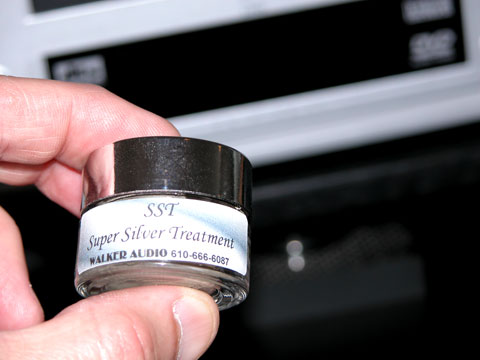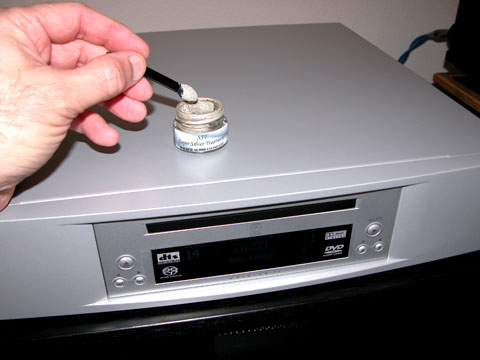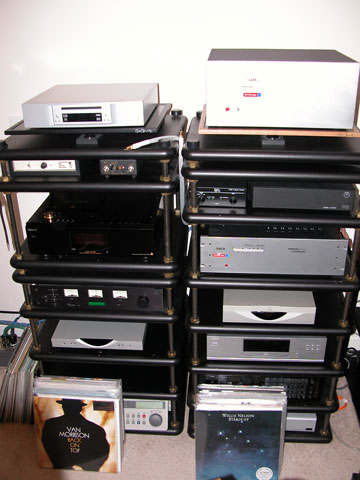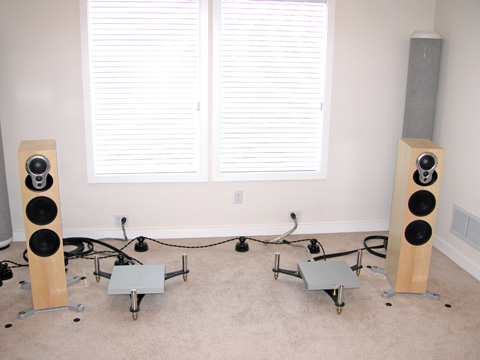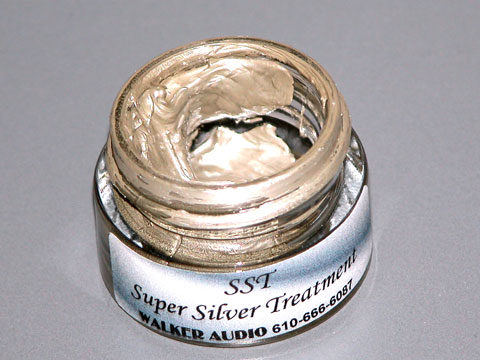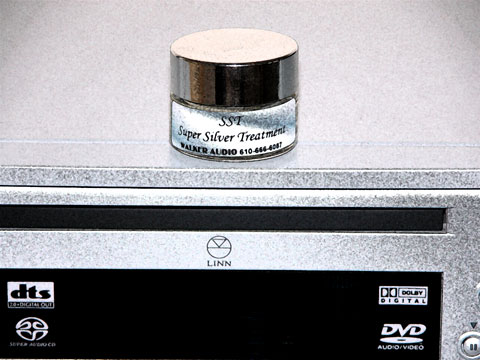|
You are reading the older HTML site Positive Feedback ISSUE 13may/june 2004
Impressions: Walker Audio's Amazing SST Contact
Enhancer
All photos and image processing by Robinson, except as noted. Jack-in-the-box time! Those of you who are skeptics on the subject of audio tweaks and enhancers may want to turn your eyes and point your browsers elsewhere, ‘cause you aren't going to like reading this. If you don't think that amazing results can come out of small packages, if you are sure that "wire is wire and connectors are connectors," if you're the audiophile equivalent of Physics in 1892, you'll want to walk on—but then you'll really miss out. You won't get to hear about how Lloyd Walker snookered me with a little jar full of some big surprises just recently, and got me hooked on an easy upgrade that's kind on the wallet. Of course, if you are interested in a for-real tweak that produces striking improvement for less than a C note: well, read on, Pilgrim, read on!
Lloyd Walker of Walker Audio (photo courtesy of Walker Audio) Short story: Lloyd Walker of Walker Audio (he of Proscenium turntable fame) got in touch with me several months ago about two fine audio products that he developed. We had a great time talking about vinyl, turntables, his Proscenium (who knows? Perhaps we'll review it some day... ), tweaks, cables, etc. Wish I had that conversation on tape; the "Lloyd Lore" was really a treat to listen to! After quite a lot of ‘phile talk, he put the question: would I be interested in reviewing his Super Silver Treatment (SST) Contact Enhancer for power cables, cords and interconnects? And how about his Vivid SACD/DVD/CD Disc Treatment? I told him that I hadn't played with a contact product since the days of Cramolin, but would certainly be willing to give his SST a shot—thus this review. (Ditto on Vivid; my comments on that product will follow at a later date.) True to his word, Lloyd sent along a small parcel a few days later. Inside was a sample bottle of SST... a whole 0.5 ounces of the stuff!
Walker Audio's SST in a jar: don't let your wife mistake this for a facial product! Also in the package was a single sheet of instructions, plus some special applicators to put SST in place.
SST and an applicator thereof... Unfortunately for the timeliness of these notes, Lloyd's product arrived at rather a crazy time in my listening room. I was just getting ready to put into place Karl Schuemann's Ultimate Monitor speakers (mini-review forthcoming), and didn't want to change that many variables all at once. Lloyd agreed... heck, he was heading for Egypt (?!) anyway... so we'd check back in when he got back. Poor guy! At the end of the promised time, Brian Morris of Linn UK came to town with a pair of the very fine Linn Akurate 242's for the queue, which meant another "set up and settle down" session of a week or so, to allow things to gel. Lloyd called, interested in my reaction to the SST, and I had to put him off for a few more days until things were ready. Lloyd's a mellow guy, rolled with the delay, and told me to let him know how it went. Finally, I reached the following Saturday, with no further interruptions in sight. Out came the jar of SST, which I have to confess I looked at rather dubiously. Could anything worthwhile come out of such a dinky jar? Naah! Then again, I've heard some pretty astonishing things happen in audio tweakerdom... So, I read the instructions carefully, several times over to get the feel of things. Walker is careful to explain that SST is not a contact cleaner, but is rather a contact enhancer. SST is a particular formulation of silver particles suspended in a viscous goop (techie term). It isn't intended to remove oxides, contaminants or buildup from your system's connection points, but is instead applied to those points to provide an extremely enhanced electrical junction. By removing the possibility of micro-arcing, dioding, and insufficient/distorting signal I/O, SST reckons to significantly improve the quality of signal transmission across those interfaces. As I understand it, then, this means that SST isn't a "Q-Tip and elbow grease" approach to contact management; instead, it's an integral aspect of proper audiophile system interconnection. The SST applicator is unusual looking... no Q-Tip here! Instead, there's a shaft that's several inches in length, with a flattened pad at one end. This allows the user to carefully spoon a VERY SMALL amount of the SST onto the end, and apply it without slopping it around or overdoing it. Me, I practiced a bit with this tool... I didn't want to make a mistake. Why the caution? Simple. Remember that SST is a contact enhancer. It actually improves electrical contact and acts as a superconductor for electrical signals. (See where this is going?) The instructions are at pains to warn about the results of glad-handing or globbing on the goo on the theory that "if a little is good, then a lot is better!" This is a genuinely bad idea—SST improperly applied will show you a number of new ways to short circuit your gear, with predictably nasty results. Such an error will put you in the way of a voided manufacturer's warranty, amigos. Proceed with caution, and at your own risk—you've been warned! As in... if you have poor eye-hand coordination, or fuzzy close-up vision, get help for this project. Do not glop it on! (All of which made the 0.5 ounce jar look a good bit more adequate; as you're going to use only a small amount of SST on each contact, you should get decent mileage out of it, dinky as it is.) Anyway, this meant that I did a trial application or two before I got down to cases, something that I recommend you do, as well. For example, the instructions made it clear that with RCA (unbalanced) connectors, SST should only be lightly applied to the MALE pin, about ½ to ¾ of the way from the tip to the base of the pin, and likewise lightly applied to the OUTSIDE of the FEMALE RCA connector. With XLR (balanced) cables, the application should be made to the MALE pins only. The spades or bananas of speaker cables can be treated, as can the MALE pins of one's favorite power cord, and the MALE pins of the IEC connector (if you have one on a given component). Surprisingly, Lloyd also recommends that tube lovers use SST carefully on the pins of their tubes to improve performance, though I don't have a tube amp in hand that I could try this with. (Next time I do, though, I'm going to give this a shot.) He also says that video cables can be treated for notably improved results—that's something that I'll try in the near future. It all sounded intriguing... time to give it a shot!
Ye Olde Editor's source end of the system that was SST'ized (the Linn Unidisk 1.1 is at the top left)...
... and the far end of same, with the Linn Akurate 242 speakers in place. To really try to get the range on the effect of the SST, I warmed up my current system with some fine tunes for a couple of hours, listening carefully to some favorite reference SACDs. (For the curious, these included the brilliant Proprius SACD of Cantate Domino—you do have it, don't you?—FIM's exceptional new SACD of harp music, Arabesque, Sony Music's exceptional Blood, Sweat and Tears, and Mobile Fidelity's Blood, Sweat and Tears 3.) Once I was sure that every thing was in the groove, I moved as quickly as possible to apply the treatment, to preserve my general aural impressions of "before." (Yes, I know... this is hard to do. You have to know your reference recordings and your system/room very well, and move fast! Even then... ) I decided to start with the Linn Unidisk 1.1 universal player that I had been using as the source during warm up. Having changed to a different input, zeroed the gain and muted the EMM Labs Switchman-3 preamp, I powered down the Unidisk 1.1. I unplugged the JENA Labs unbalanced interconnects, and treated the RCA's as I described above. It took just a smidgeon of the SST to do the job quite well; I coated ½ of the male pins, and went quite sparingly around the outside of the female jacks on the Unidisk 1.1. Then I repeated the process with the Switchman-3 preamp side of the JENA Labs interconnect. After I completed the process, I powered the Unidisk 1.1 back up, changed the input on the Switchman-3, unmuted and reset the gain to the exact same level that I had been listening to previously (the exceptional remote control on the EMM Labs unit makes this easy to do). Onto the couch I went, and fired up Cantate Domino on SACD once more... I have to say that I really wasn't sure of what I would hear. SST certainly looks like silver in an ointment base...
A close-up of the SST treatment... white magic, for sure! ...but would it make a difference? Back on went Cantate Domino, one of the truly great recordings in audio, and an acid test for timbre, tonality, detail, soundstaging (height x width x depth), and imaging. My good friend Dave Glackin and I both swear by this one in all formats... it would certainly show me if good things were happening. Shazow! Night and day. Simple as that. I immediately noticed several benefits. First of all, the clarity and spaciousness of instruments, voices and the sound space in the recording were notably improved. The Unidisk 1.1's ability to resolve spatial cues and depth in the venue were bettered. I particularly liked what SST had done to help the Unidisk with transients, helping in the presentation of dynamics. I also appreciated the way that subtle nuances in female voices were delivered with greater delicacy, and a glowing detail that the untreated signal path had not achieved prior to the SST treatment. This was great stuff! And certainly encouraging enough for me to essay the application of SST elsewhere. I decided to treat my JENA Labs XLR's male pins, as well as the bi-amped JENA Labs Pathfinder speaker leads, the FIM power cables, and the Linn Klimax IECs. So I powered off the system, and very carefully treated ½ of the male pins listed above with a very light coat of SST. Then everything was reconnected for a second run of Cantate Domino. Woah! It's the jack-in-the-box!! Like, yowzah!! Bring on the music!! The collective effect was a significant step forward in system transparency with the Linn Unidisk 1.1 as the source. The Linn Akurate 242 speakers, very fine floor monitors with the innovative Linn driver array (review forthcoming) borrowed from the Komri, lost a light layer of haze that I hadn't even realized was there until I applied SST. Spaciousness and transparency were further heightened, with a resultant pleasant increase in image specificity. Transients were now being delivered in a way that really impressed me, and dynamic swings were noticeably more effortless. Any sense of grunge or grain in reproduction was wonderfully reduced. The dynamic range of plucked harp strings by Isabelle Perrin on FIM's Arabesque: a Journey into Harp Artistry was rendered with greater realism and improved presence, drawing me much further into the music. The sound of the recording studio in Blood Sweat and Tears... the roundness of the percussion, the extension of air... were all much better than the Unidisk 1.1 had previously been presenting. Without doubt, the collective effect was nothing less than the equivalent of an important system upgrade... your choice of component! And frankly, I don't think that any single component upgrade would be quite like the collective result that I heard from the treatment of the entire signal/power path. To put it bluntly: Use of Walker's SST produced a very substantial gain in system synergy. By improving the transmission of fine audio signal at every junction/interconnection point, SST moved the performance of the entire system to a higher level of system coherence. This is a bloody remarkable achievement. I therefore dub SST as standing for "System SYNERGY Treatment"! (Lloyd and company, take note!) Three practical notes First of all, Walker Audio says that SST will bring immediate benefits (it does), but that over the next few hours... and up to a day... the improvement will continue to grow. That squares with my experience; it took 3-4 hours in this system to reach optimum clarity and coolosity. I didn't notice much improvement beyond that time period. Second, Walker notes that you should be able to unplug/replug a connection 6-8 times before you ought to re-apply SST. I haven't evaluated that yet... I haven't done enough switching on the connections yet. Third, don't use it just to use it. If you aren't pulling interconnects on and off, leave it alone. Remember: this isn't a contact cleaner, it's a contact enhancer.
Conclusion Well, what can I say? The results of the application of SST were truly amazing... and I've done a pretty fair amount of audio tweaking over the years. One thing's for sure: my use of Walker's SST showed me that audio reviewing is fraught with pitfalls and surprises (as my good friend Clark Johnsen is wont to point out in his PFO columns... and rightly so!) With Walker Audio's SST in the system, the performance of the associated components achieved higher levels of synergy and system simpatico and good juju. My review of the Unidisk 1.1 and the Akurate 242 speakers, for example, will certainly benefit from the use of SST, since it made it possible to hear so much more of what the components in this system configuration had to offer. Had I not used SST, my review commentary would certainly have been less positive, and for reasons completely unrelated to the capabilities of the components. That is a sobering realization for fine audio. How many reviews over the years have been colored by imperfections/flaws that had nothing to do with a particular design? How much ink has been spilled in blame that was actually reflective of an ignorance of the importance of the "simple" (I think not!), humble, less obvious things of fine audio? Good questions, I think. Instead of having my impressions of this system colored by imperfections at the signal junctions, I am now able to hear much more clearly what a combination of components, or a recording, have to offer. I'm tempted to go so far as to say that you aren't really hearing what a system can do until SST has been properly used in the paths thereof. Audiophiles everywhere need to pay attention to this product... and audio reviewers certainly must keep a jar of SST handy! Get to it, folks! A final word of caution, though: SST is clearly a highly conductive substance. The very same properties that have led to such remarkable improvements in my listening room are equally capable of causing damage if SST is improperly applied. So, I guess that means you're reading a rave... if so, I'll rave on! Keep up the good work, Lloyd—SST is a winner. Walker Audio SST Contact Enhancer: $70 per 0.5 ounce jar (introductory price)
Walker Audio An addendum by Dave Clark Lloyd also sent me a jar of the SST cream and after reading David's thorough account, all I can say is Amen Brother! Having used many different "treatments" for interconnect, speaker, and AC connections (Tweak, various dielectric ointments, Pro Gold—though while that is a contact cleaner, it is claims to be an enhancer as well, and a few others that I am a bit too embarrassed to admit!), the SST is by far the most effective while not gunking things up the least bit at all. I have had it in house for several months and after changing the connections far too often, have yet to notice any tarnish or problems with it coming off. True after a few dozen changes of cables, I did find a need to reapply the beauty cream, but it seems to last with no ill affects. A good thing in our environmentally challenged world where anything seems to fall apart way too quickly. But, yes, it does require a steady and frugal hand, so apply it sparingly with an eye towards keeping it where it needs to be. One can fry their systems and if you get too much on, just be careful. Along the same lines, I did find that is is way too easy to get it on your fingers and mess things up a bit, but some alcohol cleans it right up, so not to worry—have fun, and like I said, just be careful. My results are, as I said earlier, in direct agreement with David's—my system has moved up a few steps in terms of resolution without any added brightness or glare (what one would assume by adding more silver into the recipe, but not what one hears with the SST), and an increase in harmonic continuity or to put into other words, a more seamless top to bottom "gestalt" or "organic wholeness" to the music. The music just is, though there is more of it to enjoy! Put simply, there is more information presented in a "natural" sense without any spotlighting or stripping away of the richness that the term resolution may bring to mind. The resolution occurs from top to bottom—not just in the areas of the mids and on up—but across the board. An amazing effect! Now, I have a friend who has tried this on his system and found that he was getting too much "information"—that is he was hearing more than he wanted to hear and felt that the music was too over the top. Is this more an issue of letting one know that things are not quite right in Audio Town? Perhaps yes, but perhaps no. I do know that his system is very nice indeed and has been "balanced" with a very good ear. What may be happening is that too much is simply too much. Perhaps, one only has to treat up to a point and then leave well enough alone. I have so far only dealt with a few connections in my system (preamp to amp and amp to speakers) and have yet to cross over this threshold—assuming there is one! But at this point it is quite revelatory and such an easy recommendation, that like Aspirin, it should be in everyone's house! Highest recommendation.
|


